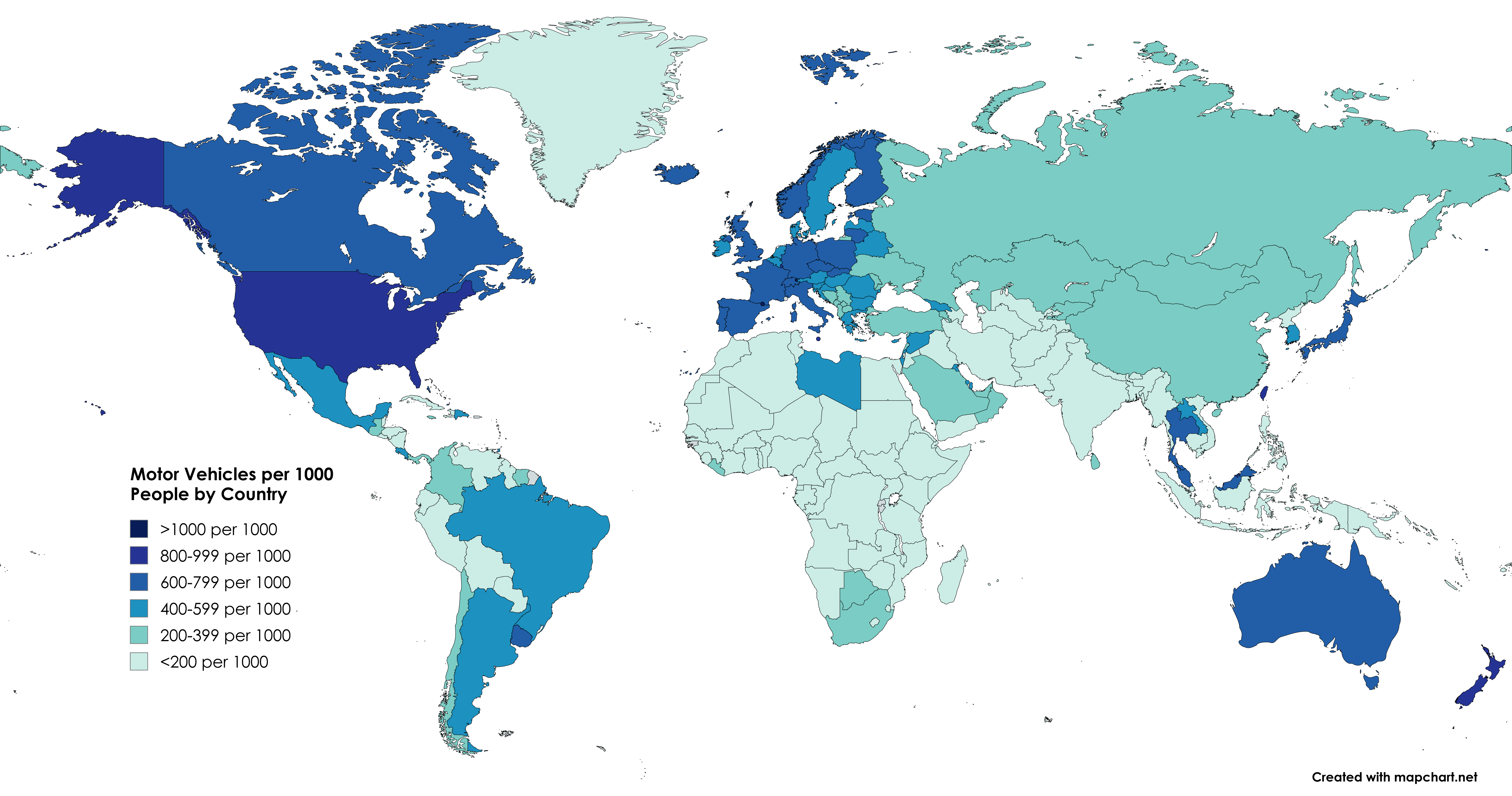Motor Vehicles Per 1000 People by Country Map


David Chen
Data Visualization Specialist
David Chen is an expert in transforming complex geographic datasets into compelling visual narratives. He combines his background in computer science ...
Geographic Analysis
What This Map Shows
This map displays the number of motor vehicles per 1,000 people by country, providing a clear visual representation of vehicle ownership across the globe. It highlights both well-developed nations with high vehicle density and developing countries where motorization is still on the rise. This visualization serves as a window into the transportation habits, economic conditions, and urban planning strategies of various nations.
Deep Dive into Motor Vehicle Ownership
Motor vehicles have become a cornerstone of modern society, stimulating economies, shaping urban landscapes, and influencing environmental policies. The rise in vehicle ownership over the past century has been staggering. In developed countries, such as the United States and Germany, the number of vehicles per capita can exceed 800 per 1,000 people, reflecting the importance of personal transportation in these regions.
Interestingly, the reasons behind high vehicle ownership rates often stem from a combination of cultural, economic, and infrastructural factors. For instance, in the U.S., the sprawling urban design and lack of comprehensive public transit systems encourage car ownership. Conversely, countries like Japan, known for their efficient public transportation networks, show lower vehicle ownership rates despite having a highly developed economy.
In contrast, many developing nations exhibit lower numbers of vehicles per 1,000 people but are experiencing rapid growth in this sector. Countries in Africa and parts of South Asia are witnessing a surge in motor vehicle registrations as economic conditions improve and urban populations expand. For example, India has seen a significant increase in motor vehicle ownership, with figures rising from just 10 vehicles per 1,000 people in the early 1990s to over 40 per 1,000 in recent years.
Moreover, the environmental implications of rising vehicle ownership cannot be overlooked. Increased vehicle numbers correlate with higher greenhouse gas emissions, traffic congestion, and urban sprawl. This trend raises important questions about sustainability and the future of transportation. Are we prepared to transition to electric vehicles, or will the internal combustion engine dominate for decades to come?
Regional Analysis
Examining the map reveals striking contrasts between regions. North America stands out with some of the highest vehicle ownership rates globally, with countries like the U.S. and Canada leading the charge. In the European Union, nations such as Luxembourg and Italy also report high vehicle density, but urban centers often promote public transport alternatives. Interestingly, Scandinavian countries like Sweden and Norway, while having high vehicle ownership, also lead in electric vehicle adoption, reflecting a commitment to sustainability.
In contrast, Latin America presents a mixed picture. Countries like Brazil show increasing vehicle ownership, yet many urban areas face challenges with traffic congestion and inadequate infrastructure. In Asia, countries like China have seen rapid growth in vehicle ownership, escalating from fewer than 20 vehicles per 1,000 people in the early 2000s to over 160 today. This dramatic increase has implications for air quality and urban mobility, prompting governmental efforts to enhance public transportation systems.
Meanwhile, in Africa, vehicle ownership remains relatively low overall, but nations like South Africa are witnessing a burgeoning automotive market. The disparities in vehicle ownership reflect broader economic and developmental trends, as well as the diverse challenges faced by different regions.
Significance and Impact
Understanding the distribution of motor vehicles per 1,000 people is crucial for several reasons. It provides insights into economic development, urban planning, and environmental sustainability. As urban populations continue to swell, the demand for effective transportation solutions becomes paramount.
Moreover, this trend toward increased vehicle ownership presents challenges related to traffic congestion, air pollution, and energy consumption. Addressing these issues requires a multifaceted approach that includes investments in public transport, promotion of alternative energy vehicles, and thoughtful urban planning.
Looking ahead, the future of transportation may very well hinge on how countries navigate these challenges. With increasing awareness of climate change and its impacts, many nations are setting ambitious targets for reducing carbon emissions, which includes transitioning to electric and hybrid vehicles. Have you noticed how electric cars are becoming more common on the roads? This shift could significantly alter the vehicle ownership landscape in the coming decades, making the analysis of motor vehicles per capita an essential topic for understanding global mobility trends.
The map of motor vehicles per 1,000 people serves not just as a snapshot of current conditions but as a lens through which we can examine the evolving dynamics of transportation, economy, and environment across the globe.
Visualization Details
- Published
- August 17, 2025
- Views
- 212
Comments
Loading comments...